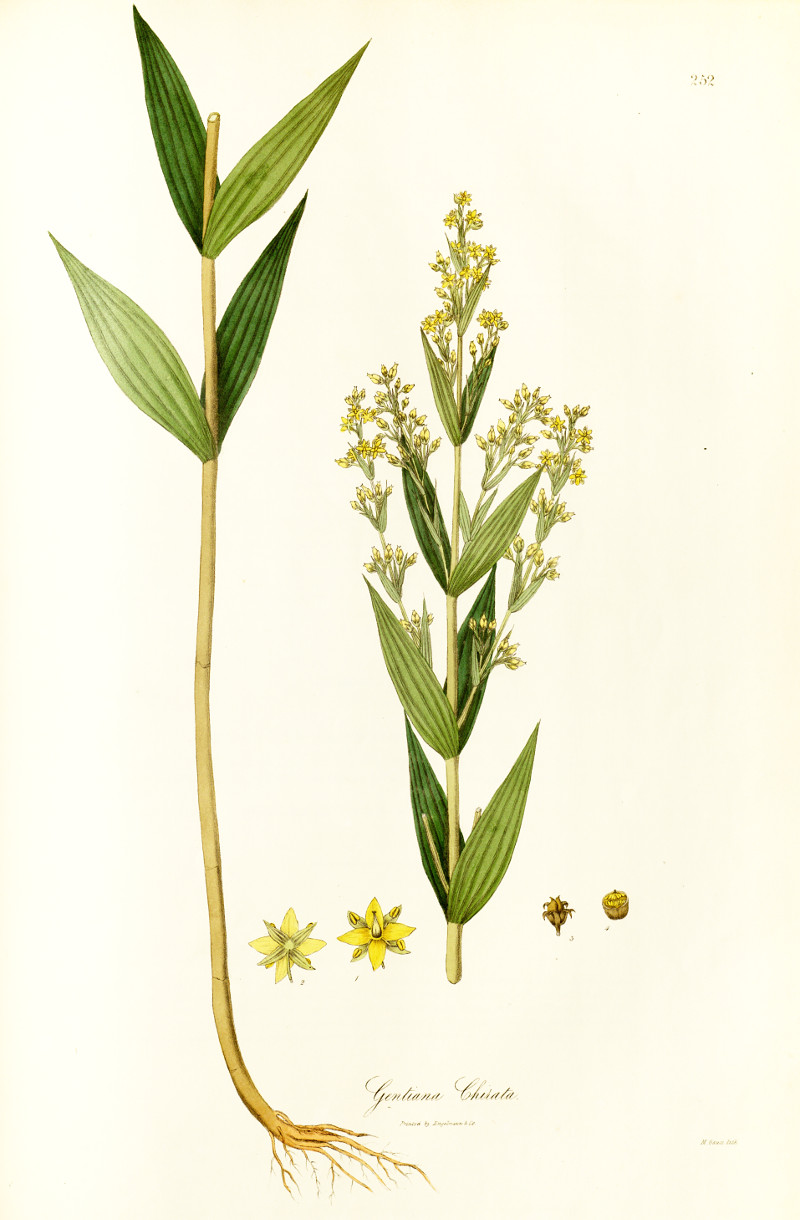Swertia chirayita (Roxb.) H. Karst. - syn.Swertia chirata Ham.; Gentiana chirata Wall.; Gentiana chirayita Roxb - Gentianaceae
chirata (India), चिराईतेf chiraito (Nepal), chiretta, Chirettakraut
Erect annual or biennial herb, up to 90cm high, endemic to temperate Himalayas (India, Nepal, Bhutan); taproot short, simple; stem purplish or brown; flowers green-yellow, tinged with purple.
„Among the different species of Swertia reported in India, Swertia chirayita is considered the most important for its medicinal properties. The bitterness, antihelmintic, hypoglycemic and antipyretic properties are attributed to amarogentin (most bitter compound isolated till date), swerchirin, swertiamarin and other active principles of the herb. Herbal medicines… contain chirata extract in different amounts for its antipyretic, hypoglycemic, antifungal and antibacterial properties… The widespread use of S. chirayita in traditional medicine reflects its pharmacological importance. However, existing populations of S. chirayita are diminishing.
[Swertia chirayita- an overview., Joshi, P., Dhawan, V., Current Science -Bangalore-, Vol.89(4), 2005, 635]
http://tejas.serc.iisc.ernet.in/~currsci/aug252005/635.pdf
The root extracts showed three main constituents and their derivatives (HPLC): mangiferin (0.001-0.46mg/g dry weight), amarogentin (0.002-0.28mg/g dry weight) and swertiamarin (0.01-1.28mg/g dry weight) were identified in aqueous and 12% ethanolic extracts of all plant parts.
… mangiferin, amarogentin and swertiamarin have been reported to possess properties such as antihypoglycemic,
antilipidemic, antiatherogenic, cardioprotective, immunodilatory, cardiotonic, anti-inflammatory, analgesic,
antioxidant, gastroprotective, hepatoprotective, anticholerogenic which may be responsible for its therapeutic action against diabetes, hypertension, chronic fever and their complications.
The infusion of Swertia chirayita is locally used in Nepal as an anti-diabetic. A review of literature indicates that mangiferin seem to have several modes of actions for counteracting diabetes and its complications; directly by stimulating insulin production, enhancing glycolytic enzymes, inhibiting alpha-glucosidase and other enzymes such as maltase, sucrase, isomaltase and aldose reductase and indirectly by its
antioxidant capacity and analgesic, anti-inflammatory, antiatherogenic, cardioprotective and antihyperlipidemic properties.“
[Quantification of major phytochemicals of Swertia chirayita, a medicinal plant from nepal., Phoboo, S., Pinto, M.D.S., Bhowmik, P.C., Jha, P.K., Shetty, K., Ecoprint: An International Journal of Ecology, Vol.17, 2010, 59-68]
http://www.nepjol.info/index.php/ECO/article/download/4118/3477
„Due to over-harvesting, lack in conservation and cultivation, this species is still in threat as categorized
vulnerable by International Union for Conservation of Nature (IUCN), (2000). Therefore sustainability of
production and marketing is the major concern along with the dissemination of cultivation technology…
Chiretta plants constitute two main intensely bitter principles, ophelic acid and chiratin both amorphous
and indistinctly crystalline yellow substances. Acceptable level of bitter principle content is above 1.3 %, which contains a bitter glycoside amarogentin, numerous tetra oxygenated xanthones including swertinin (7,8-dihydroxy 1,3-dimethoxyxanthone), swertianin (1,7,8-trihydroxy-3-methoxyxanthone), swerchirin (1,8-dihydroxy- 3,5-dimethoxyxanthone), decussarin (1-hydroxy 2,6,8-trimethoxyxanthone), isobelidifolin (1,6,8-trihydroxy-4-methoxyxanthone, 1,3,7,8-tetrahydroxyxanthones), 1,8-dihydroxy-3,7-dimethoxyxanthone, 1-hydroxy 3,5,8-trimethoxyxanthone, mangiferin (1,3,6,7-tetrahydroxyxanthon-c2-alpha-D-glycoside, and several other; triterpenes (luperol, alpha-amyrin, etc) and monoterpene alkaloids, among others…
The bitter principle as a main indicator of medical herbs, varied from 0.95 to 2.0% in the tested samples of
Chiraito. Higher bitter principle (2%) was found from wild Chiraito of 4 locations (Taplejung-Suketar and
Phawakhola site, Terhathum-Bhusune-Jiptare and Nuwakot). Pharmacopeial limit of bitter principle is 1.3%. Two other samples also crossed this limit (Dhading- Toplang 1.5% wild and Sindhupalchok- 1.5% cultivated).“
[Quality of Chiretta (Swertia chirayita) in Cultivated and Wild Samples Collected from Different Districts of Nepal., Barakoti, T.P., Tiwari, N.N., Yonzon, M., Nepal Journal of Science and Technology, Vol.13(2), 2013, 57-62]
http://www.nepjol.info/index.php/NJST/article/download/7715/6295
Swertiamarin content in extracts of S.chirayita from different locations was 0.7-1.4%.
[Quantitative Determination of Swertiamarin in Swertia chirayita by HPTLC, Laiqa Anjum, Zainul A.Ansari, Aradhna Yadav, Mohd. Mughees, Javed Ahmad, Altaf Ahma, International Journal of Engineering Research and General Science, Vol.2(6), 2014, 85-92]
http://ijergs.org/files/documents/QUAN-11.pdf

Swertia chirayita (Roxb.) Karsten [as Gentiana chirata]
Wallich, N., Plantae Asiaticae Rariores, vol.3: t.252 (1832) [n.a.]
http://plantgenera.org/species.php?id_species=988188
